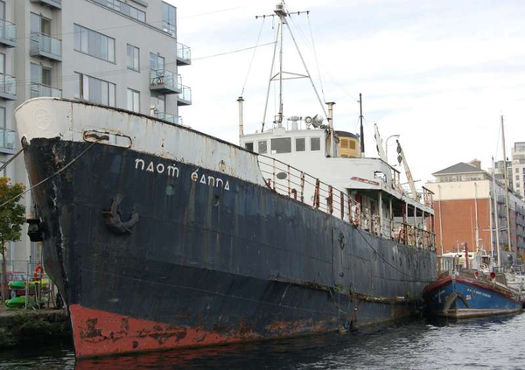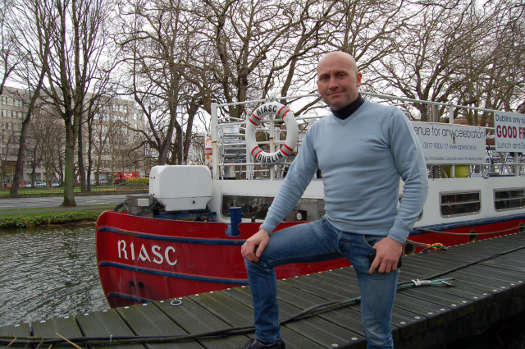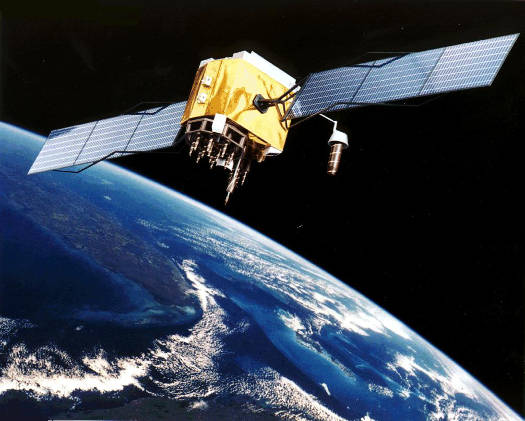#IslandNation - Readers of this blog have been kind in welcoming me back to the airwaves, for which I am grateful. Community radio on which I now broadcast is quite a big operation about which I did not know a lot until I met the people who run Community Radio Youghal, CRY104FM, in the seaside town on the East Coast of County Cork. At their invitation I returned to the airwaves, broadcasting THIS ISLAND NATION every month and with more development now ahead, thanks to the positive response of listeners.
Every week 2,000 radio volunteers around the country engage with 307,000 listeners, broadcasting from 22 fully licensed stations, in addition to which there are a number of stations at different stages of development. Community radio is a rapidly growing broadcasting sector and a force for community development, identity and expression.
A community radio station is not focussed solely on broadcast schedules, which are subject to the diktats of commercial interests for advertising purpose. So it has a stronger focus on the values and interests of the community to which it broadcasts and can provide a wider variety of broadcasting. It appears to me that it can offer what is missing from mainstream media, newspapers, radio and television - and that is a regular forum for maritime news, information, comment and opinion, related directly to communities. The mainstream media, with a few exceptions, does not give sufficient regular, informed, balanced coverage of the marine sphere.
Transmission of THIS ISLAND NATION as a monthly radio programme about the sea, with the well-known signature tune ‘Sailing By', began earlier this year and interest has grown. ‘Sailing By’ was dropped by RTE as the signature tune for the programme Seascapes, which I had developed and broadcast there for over 20 years.
NEAR FM 90.3 community radio for Dublin North East and Raidió Corca Baiscinn 94.8 FM in County Clare also broadcast THIS ISLAND NATION, as does Afloat.ie on this website. I am hopeful that more community stations around the country will join in broadcasting the programme, for which the plan now, in response to growing interest, is to increase transmission from monthly to fortnightly from next month. CRAOL is the national representative body for the community radio movement.
With modern technology it is quite easy to listen to radio stations broadcasting from anywhere around the country. The app Tune In Radio, which can be downloaded from the Google Play store, is great for listening to radio anywhere. Download it and you have access to all radio stations on Adroid smartphones, tablets, laptops and desktops. That includes, of course, those which broadcast THIS ISLAND NATION.
PRESERVING THE NAOMH ÉANNA
After what has been a long battle against what seemed to be the complete disinterest of Government and State agencies in maritime heritage, Sam Field Corbett tells me that his Irish Ship & Barge Fabrication Company has acquired the heritage ship Naomh Éanna – “effectively securing the vessel for the next three months,” he says. “During this period IS&BF will complete the in-depth survey required to calculate the cost of repairing the hull and machinery to compliment the calculations for her refit as a boutique hostel, restaurant, cafe and museum.”

The Naomh Éanna was built by the Liffey Dockyard and launched in the late 1950s. Until 1988, it served as the Galway-Aran Islands ferry and had been operated by CIE. The vessel was purchased by the Irish Nautical Trust and moored at Grand Canal Dock in 1989 after it was decided that it could no longer operate as a passenger-carrying vessel.
Waterways Ireland, owners of the Grand Canal Dock, had determined to scrap the ship, maintaining that its condition was unsafe. WI had little interest in listening to proposals for preserving the ship. There was a debate about it in the Dáil which was told that the underwater archaeological unit of the Department of the Environment did not consider that the Naomh Éanna should be protected and disregarded the fact that it was “an example of the shipbuilding techniques used in the Liffey Docks in the 1950s”. That type of history, according to the Department, did not “justify the expense that would be involved in its preservation”.
Closed minds towards maritime heritage continue to dominate official circles but Sam Corbett refused to give up. Those supporting him had to fight against the attitude of officialdom which sought to exclude several of those who could be considered ‘stakeholders’ from meetings about the future of the ship, according to those who had an open mind the future of the vessel.
Sam Corbett tells me that “the final part of the negotiations” lies with NAMA “who seem close to issuing the three-month lease on the site which will allow surveyors to access the ship and determine her condition.
“Difficulties regarding a €50,000 bond in favour of Waterways Ireland should they be expected to step in and remove (scrap) the ship should IS&BF efforts to secure funding fail, may be close to being resolved. IS&BF presented Nama with an undertaking by a recycling company experienced in specialist breaking and NAMA are considering this option. We hope to have a decision shortly.
"IS&BF are intent on approaching a number of venture capitalists to invest in the project which is presented as a viable business. How the business plan is received by potential investors will ultimately decide the ship’s fate. We have chosen to approach potential investors who have an interest in supporting Irish heritage and jobs.
“This was the original proposition since we became aware the ship was going to be scrapped many months ago. It has been a long process. Without support it would not have been possible. Indeed, it would have surely been scrapped if it had not been for the direct intervention of TDs Kevin Humphreys, Sean Kyne, Joan Collins, Eamonn O Cuiv, Senator David Norris and Councillors Mary Freehill and Dermot Lacey among others.
"Many challenges lie ahead. However, it’s a great accomplishment to have got this far. The money donated by our supporters will be used to conduct the survey as planned and the reimbursement of this money to the RNLI has been included in the project costings. We hope to be able to invite all our supporters to visit the ship when she is being restored and look forward to meeting everyone then.”
Sam Corbett Field is the man who led the restoration of the former Cork Harbour liner tender MV Cill Áirne which could also have been destined for destruction but is now a floating restaurant on the Liffey in the Dublin Docklands near the IFSC. He is also involved in the operation of barges like the Riasc on the Dublin canals. He is not a man who gives up!

Sam Corbett Field by the Riasc on the Grand Canal
GPS FAILURE
It did not get a lot of public media attention at the time, though it was well-known in maritime circles, when the satellites in the Russian GLONASS GPS system failed for 11 hours last April. It was an unprecedented total disruption of a fully-operational satellite positioning service. As a result, the Russian GPS system was completely unusable to all worldwide GLONASS receivers.
The extent of the disruption has become clear following information released by the General Lighthouse Authorities of the UK and Ireland. GLA readings from their GLONASS receiver in Harwich showed location errors of over 30 nautical miles off the UK coastline.

Apparently the problem occurred because of what were described as “bad ephemerides” being uploaded to satellites. Navigation messages from every satellite requires ephemeris data which is used by the satellite to check its orbital position and information about the time and status of the entire constellation. This data is then processed by user/receivers on the ground to compute their precise position. Less than a fortnight after the first failure, a second malfunction occurred temporarily knocking-out nine GLONASS satellites.
There are, according to information, quite a lot of GLONASS users, including some mobile phone systems. The GLA said that what happened “is a timely reminder that alternatives to satellite navigation are essential”.
The GLA themselves are supporting eLoran as an alternative to GPS for the UK and Ireland. This system transmits long-range position, navigation and timing signals from a ground-based radio network. Its primary use is for ships and others in the maritime sector, but it could provide a back-up for GPS, GLONASS and GALILEO (the long-awaited European system) when it arrives. But eLoran is still proving a hard sell to gain acceptance, according to those in the business.
A Royal Academy of Engineering report in 2011 declared that the UK was becoming dangerously over-reliant on Global Navigation Satellite Systems. Use of space-borne positioning and timing data is now widespread, in everything from freight movement to synchronisation of computer networks. The academy found that “too few of these applications have alternatives should the primary sat-nav signals go down”.
There is a detailed article about the failure of the GLONASS system and the implications for GPS in the September edition of Seaways, the international journal of The Nautical Institute.

BUYING AN ISLAND
There are a lot of interesting things happening along the Shannon, the latest of which is the decision of Clare County Council to buy Holy Island on Lough Derg, which is the largest lake on the River Shannon. The island has links back to Brian Boru. Called also the 'Jewel of the Lough', it is an important historical and ecclesiastical site, covering 50 acres of which four are in the ownership of the Office of Public Works. There are monastic ruins, including a 24m-high round tower, an oratory and church buildings. The island is still used as a burial ground. It is not far from the village of Mountshannon.
DRIFT NETS ABOLITION
The European Fisheries Commission wants to prohibit the use of any kind of drift nets for fishing in all EU waters from January of next year. It would also be made illegal to keep drift nets aboard fishing vessels. It is an all-embracing ban, typical of EU bureaucracy which does not give sufficient consideration before action to the socio-economic effects on, for example, coastal fishing communities, against whom its effects could be discriminatory.
While a ban on the abuse of these nets by big fishing boats from major fishing nations has had some positive effects on salmon stocks and protection of marine mammals, the EU and Irish Governments are ignoring the need, which is clear, for a comprehensive, long-term plan to be devised, with the involvement of local people, for the future of sustainable coastal fishing communities.
As an example of the disregard for coastal communities, the Government has still not responded to the Report of the Oireachtas Committee on Fisheries published last December that called for a Dáil debate and specific attention to be given by Government Departments to the socio-economic problems of Ireland’s coastal and island communities.
WHAT HAPPENS TO A SHIP?
Rarely does the general media report afterwards what happened to a ship aboard which a disaster has occurred. One such vessel was the MV MSC Flaminia, a German-owned container ship which caught fire on 14 July 2012, forcing the crew to abandon ship in the middle of the Atlantic Ocean. Three seafarers were killed.
Due to the damage and the cargo she was carrying, no country would give her ‘safe haven’ after the fire was put out. Eventually, nearly two months later, the German government had to respond to the requests of salvage crews and allowed the damaged vessel to be towed into Wilhelmshaven in Germany on 9 September.

The MV MSC Flaminia on fire in the mid Atlantic
In March 2013 she departed Wilhelmshaven for the Daewoo shipyard at Mangalia in Romania, where repairs were carried out. They were completed this July and the Flaminia, a post-Panamax container ship with a capacity of 6,750 TEUs and deadweight tonnage of 85,823 tons, 980 feet long and 130 feet wide, drawing 48 feet when fully laden, has returned to service. The repair work on the badly-damaged vessel included conversion into a modern eco-ship to reduce fuel consumption.
Email: [email protected]
Twitter: @TomMacSweeney
































































